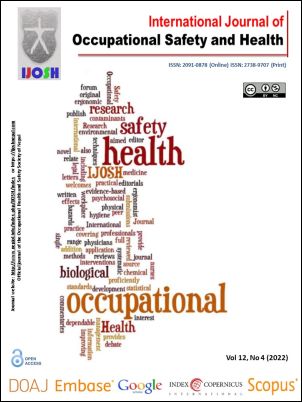Correlation between the Guyon Canal Syndrome and the Forward Head Posture in Prolonged Smartphone Users
DOI:
https://doi.org/10.3126/ijosh.v12i4.42537Keywords:
Musculoskeletal Disorders, Cervical spine, Mechanosensitivity, Ulnar nerveAbstract
Introduction: From youth to the eldest, smartphones have become an essential gadget of life. Neutral head posture plays an important role in our day-to-day activities as it is responsible for stability. Although smartphones have made our lives easier, they tend to increase the number of complaints related to the cervical spine, hand complex, wrist, and elbow pain as a result of their excessive use. This might result in various faulty postural adaptations, which can greatly contribute to the increased risk of musculoskeletal disorders. Also, its prolonged use can lead to forwarding head posture (FHP), which can be accompanied by Guyon Canal Syndrome (GCS). This study aimed to find and determine the correlation between Guyon canal syndrome and forward head posture in prolonged smartphone users.
Methods: This was a cross-sectional study that consisted of 80 college subjects who were selected based on the criterion for selection. The data that was collected included, demographic details, smartphone usage characteristics, the severity of pain, presence of FHP, and mechanosensitivity of the ulnar nerve. Statistical analysis was done using a non-parametric test. Spearman’s correlation coefficient test was used.
Results: The results of this study among the 80 prolonged smartphone users showed that 42 users (52.5%) were in the age group of 18–21, and 38 users (47.5%) were found to be in the age group of 22–25. Most of them were right-handed i.e., 61 (76%), while 19 (24%) were left-handed. In BMI, normal-weighing subjects (18.5-24.9) were 48 (60%) and overweight subjects were 32 (40%). Mean + SD of Smartphone Addiction Scale, Visual Analogue Scale, Upper Limb Tension Test and Occiput to Wall Distance was 29.99 + 6.50, 1.48 + 0.86, 0.73 + 0.45, and 2.78 + 0.96, respectively. Spearman’s correlation coefficient was shown to have a moderately positive correlation between both SAS and VAS (r = 0.36, p = 0.0010), SAS and ULTT (r = 0.14, p = 0.022), and SAS and OWD (r = 0.17, p = 0.013). Linear regression was used to check the correlation and significance between FHP and GCS, where the r value was (0.27) and the p-value was 0.0177, which was found to be statistically significant.
Conclusion: Based on the findings of this study, we found that there was a positive correlation between forwarding head posture and Guyon canal syndrome in prolonged smartphone users. FHP can give rise to moderate pressure on the ulnar nerve, which mainly supplies the fifth finger of the hand, causing Guyon Canal Syndrome. Hence, we can conclude that in subjects with prolonged usage of smartphones, FHP can further progress and these subjects may have the tendency to develop GCS.
Downloads
Downloads
Published
How to Cite
Issue
Section
License
Copyright (c) 2022 Sandeep Shinde, Akhilesh Vaidya, Prachiti Rajan Bhore

This work is licensed under a Creative Commons Attribution-NonCommercial 4.0 International License.
This license enables reusers to distribute, remix, adapt, and build upon the material in any medium or format for noncommercial purposes only, and only so long as attribution is given to the creator.





